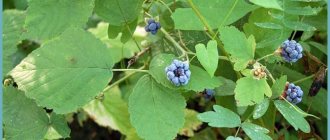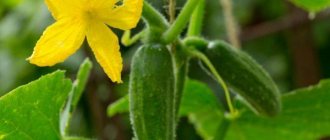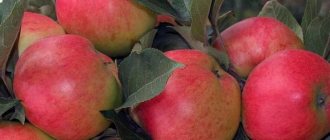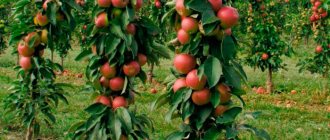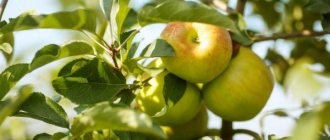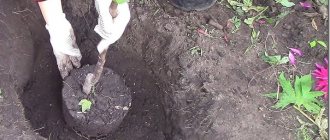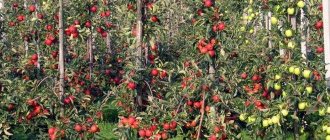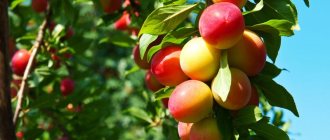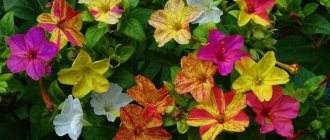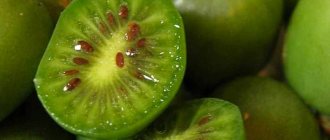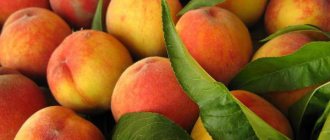Advantages and disadvantages of the variety
Cultivars with the described crown type have a number of advantages and disadvantages. Compactness - plants do not require much space, unlike a two-year-old seedling of any garden crop. Other advantages:
- The narrow crown of such fruit plantings will not shade other shrubs in the garden.
- Growing columnar peaches is easy: planting and care do not take a lot of time and resources, and do not require much experience in gardening. It’s easy to process branches, water the tree and harvest. There is no need to form a crown for such plantings.
- Varietal columnar trees tolerate winter well and are easier to cover.
- Immunity to diseases and pests.
- Great taste, large fruit size.
- During flowering, additional pollination is not required, since the tree is self-fertile.
There are significantly fewer disadvantages. The first is the relatively low yield associated with the small size of the crown. Their short lifespan makes them less attractive to gardeners: not everyone wants to replant their plantings every 5-7 years. Finally, the price of one seedling with a cylindrical crown reaches 1000 rubles, which is much more expensive than conventional types.
A little history
Do you think columnar trees are the result of the machinations of breeders? No matter how it is, nature did its best, and people just took part in an interesting process. Several decades ago, a Canadian farmer discovered an amazing tree in his garden, which had a powerful, even trunk and almost no branches.
If we found such a miracle in our garden, we would consider it a mistake of nature and throw it away, but an inquisitive Canadian decided to check what would come of this wonder. I cannot describe his surprise, since I was not there, but I know that everyone was delighted with the taste of the fruit. This is what pushed breeders to new exploits, as a result of which we got wonderful compact trees.
Of course, I can’t resist telling you about my sad experience. Inspired by the idea of growing a columnar garden, I went to the market and purchased the first seedlings. Well what can I say? The fruits have grown small and tasteless, so now I try to purchase planting material from large nurseries.
Unusual in appearance, columnar trees appeared relatively recently. To be more precise, in 1964, one of the Canadian farmers noticed a rather strange twig on one of the varietal apple trees in his garden. It, like its neighbors, grew from the main trunk, but had some distinctive features:
- the branch had no side shoots, but at the same time it was literally hung with fruit shoots with apples adorning them;
- the wood covering was quite dense and elastic.
Varieties of columnar apple trees
The following varieties of columnar apple trees are best suited for planting in the Moscow region:
- Vasyugan columnar;
- Currency;
- Moscow necklace;
- Malyukha.
Each has its own advantages over the others. And they all take root well on the soil within the Moscow region, since this climate is optimal for them.
Vasyugan columnar
The columnar Vasyugan apple tree is excellent for planting in cold regions
It can easily withstand temperatures down to -42 C in winter - which is very important, since sometimes frosts in the Moscow region are quite severe. At the same time, the tree produces fairly large bright red fruits, the weight of which can reach 200 grams. The tree has an impressively sized crown, on which there is a large number of ringlets - it is on them that fruiting occurs. A one-time harvest is about 6 kilograms
The creation of any special favorable conditions can significantly increase this indicator
The tree has an impressively sized crown, on which there is a large number of ringlets - it is on them that fruiting occurs. A one-time harvest is about 6 kilograms. The creation of any special favorable conditions can significantly increase this indicator.
The duration of the period of effective fruiting is 15 years. This is why it is necessary to renew the garden every 10 years - so that you always have a few years left in stock.
Apple Currency
The Currency apple tree is also a columnar apple tree with a fairly high resistance to frost - even very strong. The trees themselves are represented by a compact, columnar shape
The fruits can be either large or medium in size - it all depends on the ripening conditions, which occurs closer to winter. An important feature of the fruits of the presented variety is that they are stored for quite a long time - 3-4 months if the conditions are met.
The greatest advantage of the variety of this type is its amazing resistance to scab and other similar diseases, which eliminates the need to chemically treat the garden. At the same time, Currency is extremely demanding on the availability of special ground dressings. In their absence, the likelihood of fruiting is extremely low. If there is insufficient fertilization, flowering may not occur at all. It is necessary to use specialized formulations as fertilizing. which are based on mineral and nitrogen fertilizers.
It is advisable to plant seedlings of apple trees of the Valyuta variety in a well-lit, open area. You should not plant in shaded areas of the garden, in which case the likelihood of fruiting will be minimal.
Variety Moscow Necklace
The Moscow Necklace apple tree was bred through selection by M.V. Kachalkin. The original name of this variety is X2. Sometimes many gardeners still call the Moscow Necklace that way. The tree itself has a fairly small height - no more than 2 meters and, according to the classification, is considered dwarf. The root system of the tree is extremely unpretentious and resilient, seedlings take root very quickly. The Moscow necklace is extremely resistant to a wide variety of diseases.
Aeration and drainage are required. Excellent results in terms of the number of fruits are obtained by trees planted on loamy and sandy loam soils. Immediately after planting, trees must be tied up to avoid injury to the trunk. The apple harvest ripens relatively late - in mid-September and tastes similar to Melba apples. The shelf life of the harvested crop is quite long. If the storage conditions are met, the fruits can lie and not spoil for 3-4 months or even more.
Apple tree Malyukha
A distinctive feature of the Malyukha apple tree is the dessert taste of the fruit - they have excellent taste. That is why this variety is sometimes called dessert. The egg-yellow color and unusual juiciness of the fruits, which are also quite large in size - 150-250 grams, indicate excellent taste.
Variety selection criteria
When choosing a variety of apple trees suitable for the Moscow region, you need to pay attention to the following criteria:
- tolerance of local climate;
- resistance to fungal diseases and pests;
- good yield;
- precociousness;
- annual fruiting, without pronounced periodicity.
Columnar apple trees, due to their special shape, are well suited for the conditions of the Moscow region. The low density of the foliage helps the apples to be saturated with sugars.
Columnar varieties of fruit trees
Today there are many columnar fruit trees, but they are all divided into the following groups:
- grown from seeds;
- grafted onto a related tree with its own root system.
Seedlings are natural dwarfs that contain the stunting gene. Columnar varieties of grafted fruit trees are obtained through selection.
At the beginning of scientific work, only columnar apple and pear trees were grown, but today plums, cherries, peaches, and cherries have appeared on the market. The list of popular varieties includes the most delicious and productive varieties.
| Tree | Variety name | Characteristic |
| Apple tree | Currency | The fruits are sweet and sour, autumn, large, and have good keeping quality. |
| Malyukha | A small-fruited plant with bright yellow fruits, apples weigh up to 100 g, excellent taste. | |
| Nectar | An early large-fruited variety, apples with a characteristic honey flavor ripen by mid-July. | |
| Pear | Carmen | The fruits are dark red, large, sweet. Summer ripening tree. |
| Decor | Autumn pears are light yellow and medium in size. | |
| Sapphira | Yellow-green pears, tasty, keep well. | |
| Peach | Steinberg | The fruits are round, dark yellow with a characteristic blush, and medium in size. The plant is frost-resistant. |
| Golden triumph | The fruits are early ripening, with a red side, juicy and tasty. The harvest yield is friendly. | |
| Plum | Imperial | The variety is frost-resistant, the fruits have a pleasant taste with thin skin and ripen at the end of summer. |
| Mirabel | Autumn plums, suitable for processing into jam. The fruits are yellow, juicy, moderately sweet. | |
| Apricot | Star | The tree is hardy and bears large, fragrant fruits. |
| Prince | A high-yielding frost-resistant variety, the fruits are large, juicy, with good taste. | |
| Cherry | Delight | The berries are juicy, dark, sweet. The plant is productive. |
| Baby | The variety is unpretentious, bears fruit with sweet and sour aromatic berries. | |
| Cherries | Silvia | Summer high-yielding variety. The fruits are dark and juicy. The tree is heat-loving, only for the southern regions of Russia. |
| Helena | Young seedlings require shelter for the winter. The tree is hardy, early ripening, the fruits are tasty, sweet, and large. |
Varieties of columnar fruit trees are distinguished by enviable productivity and early ripening. Most of them begin to bear fruit the year they are planted. However, more often the first harvest is obtained after 3 years. A young seedling produces up to 15 kg of fruit. To increase yield, experienced gardeners cut off the apical bud on the main shoot. Such a columnar seedling produces up to 30 kg of quality fruit.
Varieties of columnar trees for Siberia
Columnar fruit seedlings were previously grown only in the southern regions of Russia, but today breeders are working on hardy varieties that will survive even the most severe frosts.
The following varieties have been bred for Siberia and the Urals:
- apple tree Iksha;
- apricot Northern seeding;
- Mirabella plum.
The columnar Iksha apple tree is distinguished by its productivity and produces large green fruits that are well preserved.
Apricot Northern sowing needs shelter, but tolerates changeable climates. Fruits with orange-red fruits.
The mid-ripening pink plum Mirabella perfectly resists the characteristic diseases of fruit plants. The harvest does not fall off the branches for a long time and is well transported.
Columnar trees in the Moscow region
The following tree varieties are popular in the central part of Russia:
- apple tree Ranet Mazherova;
- apricot Prince Mart;
- plum Blue Sweet.
The Ranet Mazherova apple tree is the best winter-hardy columnar variety for autumn ripening. The fruits are medium in size, rich yellow in color.
The large-fruited Prince Mart apricot adapts well to any new location and easily tolerates frosts down to -30 °C.
The Blue Sweet plum is famous for its medium-sized dark purple fruits. The taste of the berries is excellent.
Columnar trees for the Rostov region
Columnar apple trees Snow White have proven themselves well. The fruits ripen in late autumn and are distinguished by good keeping quality and a delicate aroma. The taste of apples is rich, the peel is green with a characteristic blush. Average fruit weight is up to 200 g.
Columnar apricot Gold is a medium-ripening tree. The fruits are aromatic, the peel is without pubescence, the flesh is tasty.
Popular varieties of compact trees
In central Russia, several varieties of columnar apricots are cultivated, which tolerate cold winters well and produce good yields.
Therefore, gardeners consider each of them in the light of the following criteria:
- climatic conditions of the area;
- growing rules;
- productivity;
- biological characteristics of the tree;
- reviews from experienced gardeners.
The greatest danger for columnar apricot is thaws in winter. At this time, the tree begins to awaken, which affects the growth of shoots and swelling of the buds. But with the return of the cold, they all die irrevocably. Therefore, in the Moscow region, summer residents try to grow not only frost-resistant varieties, but also those that can withstand winter thaws. Some of them even recover from minor injuries. Let's consider the most suitable options for such fruit trees.
"Prince Mart"
In some nurseries the tree is simply called “Prince”, but this does not affect its performance. Apricot is valued for its high and stable yield in the Moscow region, the Ural region and even Siberia. This fruit tree can withstand 30 degree frosts for a long period and continue to bear fruit abundantly.
Apricot columnar "Prince Mart" is a self-fertile plant. Its flowering begins very early, when pollinating insects are not yet particularly active. The fruits have a bright orange color and a delicate velvety surface. On the side facing the sun, a pinkish or crimson tint appears in the form of small specks. The round shape of the fruit is slightly elongated, but this does not violate its external symmetry. The maximum weight of apricots is approximately 60 grams. The juicy and aromatic pulp is bright yellow in color and has a sweet taste with subtle notes of acid.
The peculiarity of the variety is that apricots ripen almost simultaneously in early August, and in hot summers, at the end of July. The first fruits appear already 3 years after the tree is planted in a permanent place. Collecting them is quite simple, since the plant has a compact appearance and an accessible height of 2 meters.
"Star"
Another name for the variety is “Zoryany”. Its main feature is its resistance to various diseases and high frost resistance. It wonderfully tolerates air temperatures below 30 degrees, so it takes root wonderfully in the Moscow region. The maximum weight of one fruit can reach 100 grams, which is especially popular with gardeners.
Fruiting of the columnar apricot “Star” begins 2 years after planting on a summer cottage. The first inflorescences appear on it in early May, so the ovaries are not afraid of spring frosts. In mid-August, the tree bears bright yellow fruits with a cute “blush” on the sunny side. Hidden under the delicate skin is golden flesh, which is not very juicy, but surprisingly aromatic. On average, about 10 kg of fruit is collected from one mature tree.
The tree grows no more than 2 meters, which allows for safe harvesting. It does not require special care, except for timely pruning, fertilizing, and regular moistening.
Advantages and disadvantages
The main advantages of a garden of columnar trees include:
- Compact fit. Even in a small area you can plant a significant number of trees of different varieties and types.
- Stable and high yield.
- Easy care.
- Good survival rate of seedlings.
- Easier harvesting.
- Unpretentiousness. These trees easily tolerate lack of watering, and frost-resistant varieties can withstand even the harshest winters.
Despite the large number of positive aspects, columnar varieties also have their disadvantages, including:
- Short life expectancy. Unfortunately, even such long-lived trees as apple and pear trees bear fruit for only 15 years. Apricots and, especially, peaches, even less. After this, the trees have to be uprooted and the garden renovated.
- This type depletes the soil more than a regular one, so a garden of columnar trees requires more fertilizer.
- Certain skills are required to form the correct crown. Curvature of the trunk is not uncommon in trees of this type.
- High cost of seedlings.
Columnar peach
The most popular are the following columnar varieties of fruit trees.
Apple trees:
- Currency - the fruits ripen in the fall, have a sweet and sour taste and weigh up to 200 g.
- Medok is an early-ripening variety; apples ripen by mid-summer and have an excellent sweet taste. Weight - up to 250 g.
- Malyukha are small, but very sweet, bright yellow fruits weighing up to 100 g.
Pears:
- Decor - medium-sized fruits of pale yellow color, ripen by early autumn.
- Carmen are large sweet fruits of an unusual burgundy color that ripen in summer. Each pear weighs at least 300 g.
- Sapphire - yellow-green fruits weighing up to 200 g, ripen in autumn.
Plums:
- Blue Sweet - distinguished by a compact crown and large bluish fruits weighing up to 70 g.
- Imperial - has fruits with thin skin and a delicate and pleasant taste. Frost-resistant variety. In summer, watering should be frequent and abundant.
- Mirabelle are yellow fruits that ripen in late autumn. Ideal for making jam or marmalade.
Peaches:
- Gardener's Totem is a mid-early variety. The crown height does not exceed 1.5-1.7 m. The fruits are sweet with a red blush, weighing up to 290 g. The variety is unpretentious and high-yielding;
- Steinberg - tree height up to 2 m. Fruits are medium-sized, round in shape, dark yellow with a crimson blush, weighing up to 160 g. Frost-resistant variety.
- The anniversary of the capital is distinguished by the early ripening of fruits. Tree height - no more than 1.5 m. Fruit weight - up to 255 g. Resistant to diseases and pests
- Golden Triumph is a compact tree up to 1.5 m high, distinguished by early ripening of very sweet red fruits.
Apricots:
- Prince March is a low (up to 2 m) tree that is frost-resistant. Withstands up to 40 ºС frost (with shelter). Gives a bountiful harvest of bright orange fruits with an original taste.
- Star - produces large (up to 100 g), tasty, aromatic, juicy fruits. Also frost-resistant.
Columnar plum
Cherries:
- Sylvia - fruits ripen in June. Crown height up to 3 m. High-yielding variety. The fruits are large, ruby in color. Suitable for growing in the south of Russia.
- Helena is also an early ripening and high-yielding variety. Young trees must be protected from frost for the winter.
Cherry:
- Malyutka - produces high yields of sweet and sour, fragrant, large fruits. It is unpretentious. A tree with a height of 1.5 to 2.0 m with a crown diameter of no more than 0.8 m.
- Delight - the variety is distinguished by consistently high yields. The tree does not exceed 2.5 m in height, the crown diameter is up to 1 m. The berries are ruby red in color, large, weighing up to 14 g. The pulp is juicy, dark red in color.
Columnar fruit tree varieties begin to bear fruit early. Under optimal conditions, young ones can begin to produce crops in the year of planting. But most seedlings will produce a harvest within 2-3 years after planting. Varieties of fruit trees with such a crown differ in productivity. From an area of just 0.5 m² you can get 10-15 kg of fruit. Some amateur gardeners form a crown of 3-4 branches, cutting off the apical bud on the main trunk. Since the side branches grow straight upward, the shape of the crown is maintained. But from such a tree you can get up to 30 kg of fruit.
Characteristics
From the name it is clear that dwarf fruit trees have a crown shape in the form of a column, externally reminiscent of cypress. There are no side branches on the plant; the central shoot and skeletal branches grow straight upward. Flowers and fruits develop on short internodes; the shoots seem to be dotted with the crop.
The height of columnar seedlings rarely exceeds 2.5 m, but fruit plants up to 1.5 m are most common. The crown diameter of dwarfs is small, no more than 0.5 m.
You can distinguish an ordinary seedling from a columnar one by the thickness of the trunk. In dwarfs it is larger and more powerful.
Important! A characteristic feature of columnar trees is a stable, high yield.
About the ripening and fruiting of the variety
The fruits from the Yantar apple tree appear in the 7th year from the moment of grafting with eyes and delight their owners every year. Sometimes fruiting occurs in the fifth year.
The first few years, in order to allow the Yantar apple tree to strengthen, the flowers are plucked off. In subsequent years, control of the load on the branches is also necessary. This will allow you to regulate the yield and have a positive effect on the development of the tree.
At 6-7-8 years it is also important to thin out the ovaries: leave no more than 2 fruits on one branch. For mature apple trees, it is important to support branches with a lot of fruit.
For mature apple trees, it is important to support branches with a lot of fruit. Apple tree Yantar - medium late variety
On average, the flowering period falls in the first ten days of May. In more northern regions, flowering occurs later. Apples begin to ripen on average in September. In warmer regions, harvesting begins on the 15th of August
Apple tree Yantar is a mid-late variety. On average, the flowering period falls in the first ten days of May. In more northern regions, flowering occurs later. Apples begin to ripen on average in September. In warmer regions, harvesting begins on the 15th of August.
About storing fruits
Apples can be stored until the 20th of January, but in this case the harvest should be unripe, before the due date. If you pick apples too late, they should be consumed before winter.
Caring for dwarf fruit trees in open ground
Caring for columnar fruit trees has a number of subtleties. By following them, you can achieve active growth of seedlings, as well as a good harvest.
Watering
After planting, seedlings need to be watered regularly in the first months. After this, moisture is added as the soil dries.
You need to make sure there is no excess water. It leads to rotting of the rhizome.
Top dressing
There is no need to add fertilizers in the first season after planting the orchard. They are introduced starting from the second year of tree life. To do this, mineral and organic compounds are used twice a year.
Weeding and mulching
Weeding is dangerous for dwarf fruit trees. This procedure may damage plant roots located near the soil surface.
It is better to mulch the soil using:
- husk;
- peat;
- sawdust;
- straw.
Thinning inflorescences
In the first year of a tree's life, its inflorescences are removed, preventing it from bearing fruit. This must be done so that the seedling directs all its forces to:
- strengthening the rhizome;
- active growth.
To do this, all flowers are picked off.
In the next few years, the number of inflorescences is regulated, because the fragile young trunk may not withstand the weight of the crop. Of 5-7 pieces, 2 flowers are saved, the remaining inflorescences are cut off with pruning shears.
Trimming
To form a beautiful columnar shape of the crown of a seedling, you need to regularly prune it. In the first year, the length of the side branches is reduced and the growth of the crop is directed upward.
Wintering
The fragile trunk of a young tree does not tolerate winter cold well. In the first year, you need to make a shelter that will help you survive the frosts. Suitable for this:
- spruce branches;
- organic mulch;
- agrofibre.
Obtaining seedlings
Columnar fruit trees are the result of many years of selection work. Today, varietal seedlings of these plants are tested in various regions of the country; high-quality planting material can be obtained not only in foreign, but also in domestic nurseries.
To get a dwarf fruit tree, you need to meet some conditions:
- use variety 003, Arbat, Valyuta as a rootstock;
- graft shoots with the dwarf gene - Co.
Some nurseries do things differently. From low-growing varieties, for example, President, Orlinka, columnar seedlings are artificially formed.
general characteristics
I remember one of our employees.
Listening to our conversations about successes and failures in growing vegetables and fruits, she surprised me with one phrase. “And I already have some fresh ones,” she said. How? From the market! But your own tastes better! And if you want to grow the same thing yourself, consider first of all:
- Do the climatic conditions allow this?
- What are your specific growing conditions?
And for gardeners in the Moscow region we need to remember:
- Moderate continental climate - hot summers with temperatures below 30 degrees. And sometimes the mercury column jumps higher;
- And yet, it doesn’t happen from year to year. You won't get any rain. Otherwise it floods quite a bit;
- And the same 30 degrees. But already with a minus in winter. With periodic thaws. It happens that local varieties are also picked up. Not to mention the tempting visiting varieties;
- But you want to eat fresh apples longer. This is where the fortune telling begins when planning a site. What and where to plant? And how many? We tell you: Preference is given to winter varieties. They ripen in September and October. And they need to be removed slightly unripe. They will reach the stage of consumer maturity after prolonged storage. Some, under special storage conditions in refrigerators, are very suitable for consumption until new harvests. At home, gardeners also serve their apples in April. They are planted more -50-60%;
- Autumn varieties make excellent juices and jams. Their taste and aroma are just right for these purposes. And the shelf life allows you to do this - they can sit for 2-3 months. And they need to be removed in the last days of August. And others - in early September. Their share is about 25-30%;
- The remainder are summer varieties. Actually 1-2 trees. They are very juicy and sweet. But they can only be preserved for 20-25 days. We ate them while they were still green. From July to August.
Autumn varieties make excellent juices and preserves.
- And your task is to select these one or two summer apple trees for the Moscow region. Therefore, you study their properties in more detail: After all, they need to withstand winters like these. I don’t really want to deal with restoring them after freezing;
- Increasingly, buyers are interested in their resistance to disease. This especially applies to fungal diseases - scab, powdery mildew. It is the rains that contribute to their occurrence. And so that you don’t wonder later what caused some stains and deposits. Entire institutions are dealing with these problems. Absolutely immune varieties are bred;
- Gardeners are a patient people. But I want to see the result as soon as possible. So choose varieties that will produce the first apples in the 2nd or 3rd year after planting;
- And so that the apple trees do not bother you with the lack of harvest. After all, every year you want a good harvest of apples.
So try choosing one or two varieties. We will try to advise you and show you their photos and descriptions. It's up to you to decide for yourself.
Features of planting and growing in the Moscow region
Growing even a zoned variety of columnar apple tree in the Moscow region is not so easy. It is important to take into account the appropriate timing of planting and prepare for the procedure in advance. The unfavorable climate necessitates the need to take especially careful care of the plants during the first 2 months after planting.
A special condition for planting columnar apple trees is that groundwater should not be located close to the surface of the earth.
Deadlines
It is advisable to plant columnar apple trees of any variety in the Moscow region in the spring. This will allow the seedlings to take root well and withstand the subsequent winter more easily. Trees are planted in early spring, waiting until the following requirements meet:
- the soil has thawed;
- the meltwater has receded;
- the soil is well heated;
- sap flow has not started;
- the buds have not started growing.
Preparing the site and seedlings
The soil for planting is prepared in the fall by digging up and removing weeds. The soil must be mixed with fertilizers; for each square meter you can add:
- 50-100 g of superphosphates;
- 25-30 g of potash fertilizers;
- 10-20 kg of organic matter.
It is recommended to buy seedlings from a nursery, which is located in the same climatic conditions as the planting site. Plants should be inspected for damage and symptoms of infection. It is recommended to place the roots of the seedling in the soil if long-term storage before planting is planned. 12 hours before the start of the procedure, the root part of the plant is soaked in an aqueous solution of a growth stimulator, which allows the tree to begin its growing season more actively.
Algorithm and landing scheme
The planting process consists of several stages:
- Preparation of planting holes about 1 m wide and 0.6-0.7 m deep.
- Organic and mineral fertilizers are applied to each pit.
- A peg needs to be placed in the hole for support.
- The tree should be placed in a hole, spreading its roots along the earthen surface.
- The soil is poured in such a way that the grafting site remains above the surface.
- Abundant watering.
- Mulching the tree trunk circle.
The planting scheme suggests maintaining a distance of 40-50 cm between plants, and the free space between rows should be at least 1-2 m. You can also plant apple trees in the center of squares with a side of 1 m.
Watering and fertilizing
Columnar apple trees must be insulated at least 4 times during the growing season:
- Before flowering begins.
- During the formation of ovaries.
- During the period of filling apples with juice.
- Preparing trees for winter.
In the first year, it is necessary to apply additional nitrogen fertilizers before flowering and during fruit set. Plumping apples need extra phosphorus and potassium. Fertilizer application can be combined with watering.
Tree trunk care
In the first years of life, columnar apple trees require more careful care. In winter, the tree trunk circles must be insulated to prevent freezing of the root system. The layer of mulch or crushed peat should be 10-15 cm thick.
Formative pruning
Columnar apple trees are formed vertically, which differs from traditional methods. In the first year, it is necessary to trim all side shoots to 2 growth buds. Next year, horizontal shoots on the branches are preserved to form fruits, and vertical shoots are shortened by 2 buds. In the third year, the remaining shoots are cut into rings.
An important condition for formative pruning of columnar apple trees is to preserve the top buds; if there is branching, then you need to leave the strongest shoot.
Planting columnar trees
When choosing a place for planting, you must remember that columnar tree species do well in open, illuminated southern areas of the garden. They do not tolerate winds and drafts well. The land must be fertile. There should be no groundwater nearby. The composition of the soil is loose, so that there is good circulation of air and water. Loamy and sandy loam soil is suitable. Acidic soil is limed.
Spring is the most suitable time for planting seedlings. When planting an entire garden, it is necessary to maintain a distance of one meter between plants and rows.
The holes must be dug in advance to allow the soil to settle. When digging a hole, the size of the crop's root system must be taken into account. Usually a hole of 60 cm by 70 cm is sufficient. If you plan to plant an entire garden, then gardeners practice digging a trench.
A layer of drainage is poured into the recess, and potassium and phosphorus fertilizers are added one tablespoon at a time. After this, the young tree is placed
The root system is buried, carefully compacting the soil. Planting ends with watering and mulching. Caring for a columnar garden comes down to watering and fertilizing
There is practically no need to prune branches, since many varieties do not grow side shoots at all
Caring for a columnar garden comes down to watering and fertilizing. There is practically no need to prune the branches, since many varieties do not grow side shoots at all.
Young trees will only need watering for the first few years. Then their root system will strengthen, grow, and the trees themselves will provide themselves with the necessary moisture. Water the plants around the trunk. When watering in the usual way, the ground must be mulched with straw. In dry summers, the crop is watered once a week. In rainy weather, additional moisture is not required. It is good to sprinkle fruit trees periodically. This will not only moisturize the plants, but will clean their leaves of dust.
Heavy fruiting of trees leads to rapid depletion of the soil and therefore it needs additional feeding. Columnar fruit trees are fertilized in several stages. The first fertilizing with urea or saltpeter is done in the spring, when the snow melts. The following fertilizers are applied during flowering and a week after it. During these periods, cow dung diluted in water mixed with wood ash is used. The last time the trees are fed is in the fall with potassium and phosphorus fertilizers.
When lateral branches appear, pruning of columnar trees is still necessary. The cut sites are treated with garden varnish or other specialized means.
In the spring, when inspecting trees after cold weather, you need to pay attention to the top bud. If a weak shoot grows from it, and another one forms nearby, then you should wait until they both grow back and save the stronger one. Video “Is it possible to prune a columnar apple tree”
Video “Is it possible to prune a columnar apple tree”
It is also necessary to normalize the number of colors. In the first year, it is recommended to remove all inflorescences. In the second year, thinning occurs in three stages. The first stage is at the stage of bud formation, when every second of them is removed. The second stage occurs during the appearance of the ovaries. There should be twice as many of them left on the tree as the desired harvest. The third stage - the fruits are left for harvesting.
To avoid disturbing the weak root system, cereal crops or dill are sown under the plants, which are carefully mowed as they grow.
Like any fruit trees, colony trees can be susceptible to pests. If they are detected, it is necessary to treat the crops with insecticides intended for fruit trees.
Recommendations for cultivation
When creating a columnar garden, it is worth listening to the opinions of experienced gardeners. In Siberia and the Urals, even winter-hardy seedlings must be covered for the winter. There are several ways to protect plants from frost:
- build a frame base;
- cover with agrofibre.
Agrofibre can be used for several years in a row, and attaching it does not cause much trouble. But you will have to tinker with the frame shelter. Make a base from the slats, which will be covered with spunbond. This shelter option is much more reliable.
Landing
Traditionally, columnar seedlings are planted in the fall so that they can more easily adapt to the local climate and be able to take root before frost. However, in the northern part of the country, work is planned for the spring.
A leveled area without drafts in a well-lit area is allocated for the garden. The soil is preferably loose, fertile, and moisture-absorbing. The level of underlying water in the ground should not exceed 1 m.
Columnar trees have a shallow root system, so after planting, be sure to install support for the seedlings. The holes are prepared at a distance of 1 m from each other, leaving up to 1.5 m between the rows.
During planting, the bottom of the hole is well drained, covered with humus and rotted manure, and mineral fertilizers are applied. The seedling is placed vertically, the roots are straightened and sprinkled with earth. The trunk is tied to a support. The soil around the tree is compacted and watered abundantly. To maintain the required level of humidity, the tree trunk circle is mulched.
Care
Columnar fruit trees do not require special care. The main thing is to learn how to trim them correctly. If the central conductor is frozen, then the tree will give 3-4 side branches, they need to be cut off. Only the strongest one is left, as a continuation of the trunk. The cut sites are treated and disinfected.
To increase the lifespan of the tree, sanitary cleaning is carried out in the summer. Weak branches are cut out and the tops are pinched. In the fall, you can remove thickening shoots.
Columnar trees quickly deplete the soil, so nutrients need to be replenished. In the spring, complexes that are aimed at the growth of the root system are demolished. In autumn they are fed with phosphorus-potassium fertilizers. Such procedures have a positive effect on the yield and winter hardiness of the crop.
Advice! In the first year, remove all flower buds from the tree, leaving only half for the second season. This promotes good root growth.
Columnar gardens are watered regularly, but moderately. In hot weather, the water intake is increased. In rainy weather, natural precipitation is sufficient.
Columnar trees in landscape design (with photos)
Various types of columnar tree representatives can colorfully and non-trivially decorate any garden plot, artificial garden, yard or park area. Their original crowns, individually or in combination with other plants, can serve as successful decorations for any modern interior.
On the Internet, photos of columnar trees are full of variety, so landscape designers are coming up with and implementing more and more ideas with the participation of these representatives of cultural flora.
Many options are suitable not only for private plots and their landscape design, but also for public areas - parks, kindergartens, playgrounds.
You can highlight the most popular combinations and types of design:
- combinations of plants planted close to each other with weeping, spherical shapes and columnar representatives look bright and modern;
- coniferous types of columnar trees often turn out to be central plantings around which a picture of modern landscape design is created;
- combinations of these types of plants with rocky embankments or stone slides are original and often preferred recently;
- Coniferous species are often used to create hedges, frame an entrance or arch, or create natural corridors or alleys.
For owners of large territories and vast areas, large species of deciduous trees are considered relevant - columnar birches, oaks, and other varieties.
Such representatives of tree flora often have a curved trunk, but this is even a unique highlight and adds a certain flavor to the picturesque surrounding picture.
Look at the photo of columnar trees in modern landscape design - the variety of ideas is amazing:
Material prepared by SevText studio
Summer apple tree varieties for the Moscow region
Summer apples ripen earlier than other varieties. You can try them from the end of July and throughout August. Summer varieties are intended for fresh consumption, for preparation for the winter; they are not stored for long. The advantage of summer apples is that they can be eaten straight from the branch, the disadvantage is that they quickly become overripe. Therefore, be sure to plant, along with summer varieties, varieties of other ripening and consumption periods - autumn and winter.
In this article I provide a description of the 4 most popular summer varieties for the Moscow region:
- Grushovka Moscow,
- Padding,
- Striped anise,
- Kovalenkovskoe.
All these varieties are widely known. The fruits can be picked from the branches in early summer. Due to the fact that the fruits ripen quite early, they can be stored for only a couple of weeks, with the exception of anise - striped anise apples can be stored for up to 2 months.
Moscow Grushovka, or Pestrushka
Several harvests will have to be done, as the apples ripen one after another. You can wait until all the fruits ripen and collect them in a minimum amount of picking, but in this case there is a risk that overripe fruits will fall off.
The disadvantages of the variety include:
There are apples on the branches not every year, usually with a break of two or even three seasons.
The advantages include:
- moderate height of the apple tree,
- not very thickened crown,
- ringed type of fruiting,
- relatively large apples – up to 110 g.
The apples are painted scarlet, which occupies the entire surface of the apple. The fruits taste very good, juicy, with aroma, but you should not allow them to overripe, since the structure of the apple changes for the worse in this case.
Photo: Grushovka Moscow variety
Paping, or Alabaster
The fruits taste very good, juicy, with aroma, but you should not allow them to overripe, since in this case the structure of the apple changes for the worse and becomes mealy. The apples are greenish-yellowish in color, which occupies the entire surface of the apple.
The disadvantages of the variety include:
sharp frequency of fruiting.
The advantages include:
- resistance to negative temperatures in winter,
- resistance to scab,
- not very thickened crown,
- ringed type of fruiting,
- relatively large apples – up to 160 g.
Several harvests will have to be done, since apples fall off very actively when ripe.
Photo: Papirovka variety
Striped anise, or Anisovka
Due to the fact that the fruits ripen quite early, they can be preserved for only a couple of months. Several harvests will have to be done, since apples fall off very actively when ripe.
The disadvantages of the variety include:
- low early pregnancy,
- After planting a seedling for the first harvest, you can wait five and sometimes six years.
The advantages include
- resistance to negative temperatures in winter,
- resistance to scab,
- not very thickened crown,
- ringed type of fruiting,
- relatively large apples – up to 100 g.
The apples are colored with dull pinkish stripes, which occupy the entire surface of the apple. The fruits taste very good, juicy, with the aroma and taste of anise, but you should not allow them to overripe, since in this case the structure of the apple changes for the worse and becomes mealy.
Photo: Striped anise (Grey anise)
